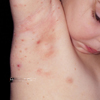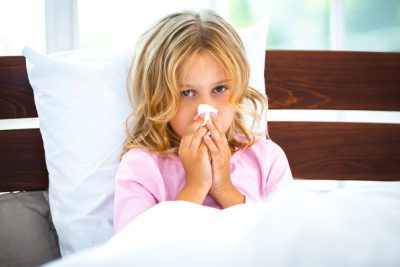What is it? Molluscum contagiosum is a common rash in children and young adults that is caused by a viral infection. Infected individuals develop firm, skin-colored, dome-shaped bumps on the skin. The middle of these bumps usually has an indentation. These lesions may itch or become red, but this is not always the case. Lesions can occur anywhere on the body except the palms and soles.

How is it spread? The virus that causes molluscum is spread by direct contact. Autoinoculation, or self spreading, can occur by touching or scratching a lesion and touching another part of the body. Molluscum frequently occurs in outbreaks in daycares. It can also be spread by sharing sponges or towels, and frequently is spread via direct contact during contact sports. It can also be transmitted by direct contact in sexually active individuals. Once exposed to the virus, it usually is two to six weeks before the rash appears.
How is it diagnosed? A physician can usually diagnose molluscum by physical examination of the rash alone. Occasionally, a lesion can be biopsied by your doctor or a dermatologist to confirm the diagnosis. Other infectious conditions, such as histoplasmosis, can have similar lesions as molluscum, but these lesions are much less common.
How is it treated? For the majority of cases, there is no need to treat. The lesions usually cause no symptoms, and resolve within a few months. Occasionally the lesions will continue to come and go for several years. In deciding to treat, one must weigh the risks and benefits. Successful treatment can limit the spread to other sites and other people, resolve itching if it is severe, prevent scarring, and help with the psychological stress of having the lesions. Treatment risks, however, include pain, dyspigmentation, and scarring. Treatment options include freezing the lesions (cryotherapy), scraping off the lesions (curettage), or using a blistering agent (cantharidin). All of these treatment options can be discussed further with a physician.
How can it be prevented? Prevention is as simple as avoiding direct contact with the lesions. Children with molluscum can still go to school or daycare, as long as all lesions are covered with clothing or a bandage. Due to a theoretical risk, while swimming a watertight bandage should be used. Do not share towels, washcloths, or personal equipment.
Please visit the following websites for further information on molluscum.
AAP website on molluscum: http://www.healthychildren.org/English/health-issues/conditions/skin/pages/Molluscum-Contagiosum.aspx
CDC website on molluscum: http://www.cdc.gov/ncidod/dvrd/molluscum/index.htm





Comments